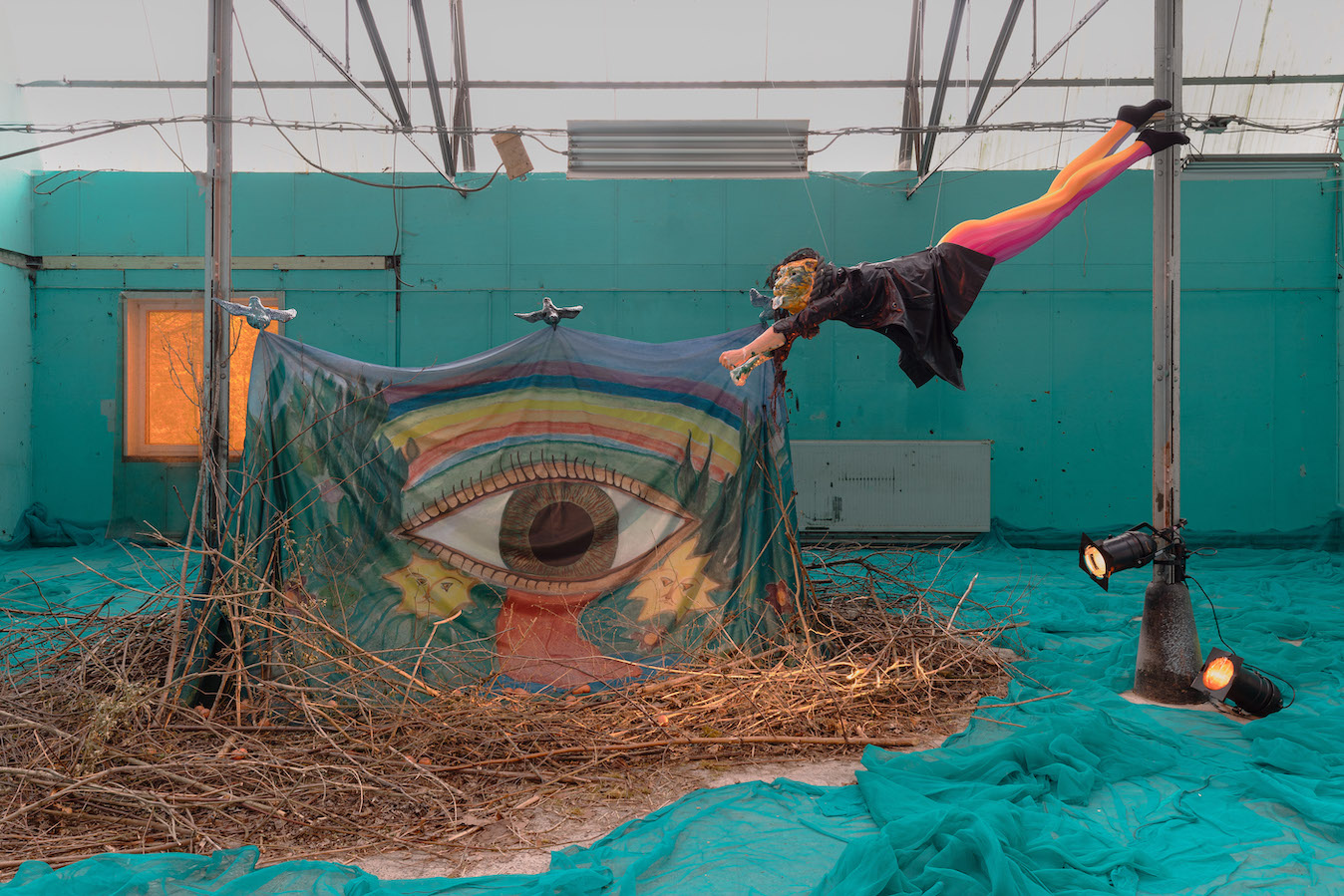
Laure Prouvost, Hovering Caresse Amère
Photo by Eline Willaert
The Act of Breathing Photo by Eline Willaert
Co-curated with Sorana Munsya
With Michèle Magema, Maika Garnica, mountaincutters, Soraya Bonaventure,
Pascale Marthine Tayou, Benjamin Orlow, Laure Prouvost, Leonard Pongo,
Kris Lemsalu, Anthony Ngoya, Jean Kabuta, Agnes Lalau and Mega Mingiedi.
Horst Arts & Music and KANAL Centre Pompidou
12.05 - 31.07.23
Production by Margot Bossy
Exhibition folder
The Act of Breathing is the title of a poem by Sony Labou Tansi. The Congolese novelist, poet and playwright, who passed away in 1995, teaches us in this work that breathing, despite being a natural reflex, is a tool in the harsh struggle against operating power systems that place society and nature in a state of suffocation and asphyxiation. The quest for this breath therefore isn’t devoid of violence, as it sets out to confront meat and flesh devourers, as the author describes the oppressor so chillingly in his work.

Anthony Ngoya, installation view
Photo by Eline Willaert
Photo by Eline Willaert
When voices are silenced, when earth is depleted, when collectivity is shattered, when music loses its soul, the stubbornness embedded within the repetitive act of breathing becomes a tool for resistance. The Act of Breathing considers Congo as a pathway, an exemplary reminder of how the constant reclaiming of air amidst oppression and suffocation, can be a space for battle, for gathering, for healing. For the joined act of breathing is a connective alliance, a potent force to remain in life.
The Act of Breathing, a poem in 7 acts, exists as one long breath that whispers or shouts the necessity of its existence in our ears: it is the breath, the voice, the cry stemming from Congolese people in Belgium who also define the country. It is exactly through this breath that our environment can be modified, that the inherent nature of our spaces is transformed to allow for the imagination of another society.
For the tools, through which history is written and through which power is exerted, have something in common: they are physical and never cease to impose themselves visually. History books, painted portraiture, monuments erected in stone, bronze and marble, and stately buildings penetrating public space forcibly remind us of who’s in charge. The Act of Breathing therefore resorts to other portals to disrupt the singularity of this narrative of oppression. The human breath and the voices it produces, are excavated from the silence in which they have been suffocated for far too long. Digging deep into the raw earth as described by Sony Labou Tansi, we find communal histories, personal recollections and societal events which have been deliberately obscured and silenced. Digging them up, they are again allowed to breathe and resonate. By being confronted with them, we too, can allow our perception to breathe, open up and see anew.

Leonard Pongo, The Uncanny
Photo by Eline Willaert
Photo by Eline Willaert

Benjamin Orlow, Ritual City
Photo by Eline Willaert
Photo by Eline Willaert
The sound created by this breath, the voice generated by this act of breathing, is considered in this exhibition as a crucial element in the perception of space and things. The voice has the ability to transform the vision we hold of our environment, taking as an example the voice of people fighting for a more respectful public space for the voiceless, thus changing our interpretation of institutions, colonial monuments, statues and the form in which they appear to us. The artists in The Act of Breathing call upon our senses to hear these voices and provoke a collective breath.
By bringing together artists between Vilvoorde and Brussels, the majority of whom from Congolese descent, we approach the human breath as a shared entity. The exhibition manifests itself as a metaphoric circuit, a collective ecosystem in which being able to breathe comes down to allowing others to do so. It is in the collective act of breathing that stubbornness transforms into a potent tool for resistance. It is by relentlessly sharing these stories that perceptions can shift, forefronting narratives that render structures of oppression powerless.

Kris Lemsalu, Pinal Gland
Photo by Eline Willaert
Photo by Eline Willaert

Michèle Magema, Sonographies: L’Acte de Respirer
Photo by Eline Willaert
Photo by Eline Willaert

Soraya Lutangu Bonaventure and Ali-Eddine Abdelkhalek: Taking Care of God
Photo by Eline Willaert
Photo by Eline Willaert

Installation of the chapter at CINEMATEK, with Agnès Lalau and Méga Mingiedi
Photo by Eline Willaert
![]()
Photo by Eline Willaert

Méga Mingiedi, Restitution des Bikekos
Photo by Eline Willaert
![]()
mountaincutters, mais, la présence au monde
Photo by Eline Willaert
Photo by Eline Willaert

mountaincutters, mais, la présence au monde
Photo by Eline Willaert

Pascale Marthine Tayou, Le Mur du Silence
Photo by Eline Willaert
Photo by Eline Willaert

Maika Garnica, Subtle matter, fluid hands
Photo by Eline Willaert
Photo by Eline Willaert